In order to predict future price movements, investors and traders commonly engage in technical analysis, which involves charting trendlines and patterns on the price charts of financial assets. This approach can help traders plan their strategies, identify entry and exit points, and gain a competitive edge in the market.
When combined with technical indicators, chart patterns become even more reliable and can lead to the foundation of a successful trading strategy. Among the most popularly used and relied on technical indicators, is the Relative Strength Index.
Relative Strength Index Definition
The RSI, or Relative Strength Index, by definition, is a technical analysis indicator first developed by J. Welles Wilder in 1978, designed to measure the strength, speed, and change of price movements on the price charts of financial assets like forex, stocks, crypto, and more.
The RSI can assist traders with understanding when trends are running out of steam and a reversal could be near, by indicating when an asset is currently oversold or overbought.
Why The Relative Strength Index Matters
Trends are incredibly powerful and driven by market momentum. The RSI matters because it can help traders understand if that momentum is waning, or if the momentum is strong enough to carry the price of an asset even higher or lower.
How the Relative Strength Index Works
With each increase or decrease in price, the RSI values will also move according to the direction of the price. When the RSI reaches certain values, it will signal that an asset is oversold or overbought and that a trend may be coming to an end, or a reversal may be near. Knowing this in advance can assist traders with understanding when to make an entry into a position, or to exit a position that is already profitable before the price reverses.
However, during the most powerful trends, assets can stay oversold or overbought for an extended period of time, so the RSI works best in conjunction with other technical indicators such as the MACD or Bollinger Bands. These results may change depending on if the asset market is in a downtrend or uptrend.
How the Relative Strength Index is Calculated
The Relative Strength Index is calculated using the following simple two-part formula:
RSI = 100 – [100 / (1 + (Average Gain / Average Loss))]
The averages are taken across the last 14 periods, and the longer the period extends, the more accurate the RSI value becomes.
How to Read the Relative Strength Index
The Relative Strength Index is an oscillator that ranges from zero to 100, and that number varies depending on the strength of the trend or price movement. 50 is considered neutral territory, but as soon as the RSI goes above 70, the asset is considered overbought. Alternatively, when the RSI falls below 30, it is considered oversold. When either number reaches an extreme, the higher the likelihood that the momentum may soon reverse in the other direction.
How to Use the Relative Strength Index
The most common way to use the Relative Strength Index is to watch for any oversold or overbought conditions, typically a reading of under 30 for oversold and over 70 for overbought, before taking a position and putting any money at stake. If the RSI rises too high, and the signal crosses into overbought territory, a trader may want to take a short position in order to profit from the market turning in the other direction.
Some of the top analysts also draw support or resistance trendlines on RSI charts to show where certain limitations may lie that could cause an asset’s price to reverse. No advanced settings are required for RSI to work well alongside the right trading strategy.
The Best Relative Strength Index Trading Strategy
The Relative Strength Index can be utilized to design a winning trading strategy. Here is an example of the most straightforward RSI trading strategy that can be easily implemented by anyone regardless of skill level or experience.
The most common way traders use the Relative Strength Index, is by watching for the indicator do rise above 70 or below 30 for an overbought or oversold signal. Once the RSI reaches these key areas, a trader can open a corresponding position.
Buy Signal When RSI Reaches Under 30
Throughout Bitcoin’s bear market, each time the crypto asset reached support at $6,000, the RSI signaled that it was oversold by touching or reaching below the 30 line on the RSI. Each time this occurred, the buy signal was accurate resulting in at least a $2,000 rise each time. A reading on the indicator below 30 can also be used to plan the exit of a successful short trade.
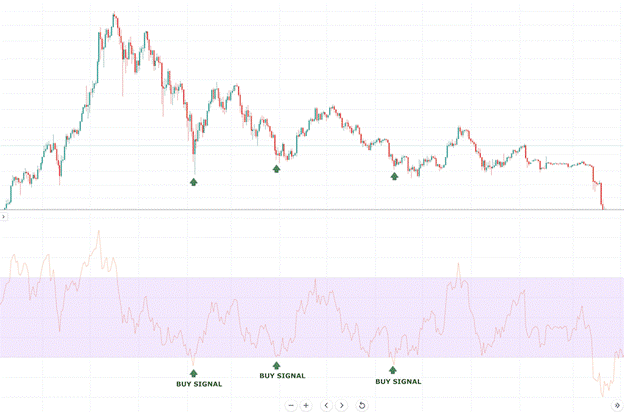
Sell Signal When RSI Reaches Over 70
Much like a reading below 30 can be used as a signal that an asset is oversold and a potential buy, any readings ver 70 suggest an asset is overbought and a correction could soon result. Each time the Relative Strength Index reached over 70 on the sample gold chart, it resulted in a strong drop and successful sell signal. Readings over 70 can also be used to plan the exit of a long trade.
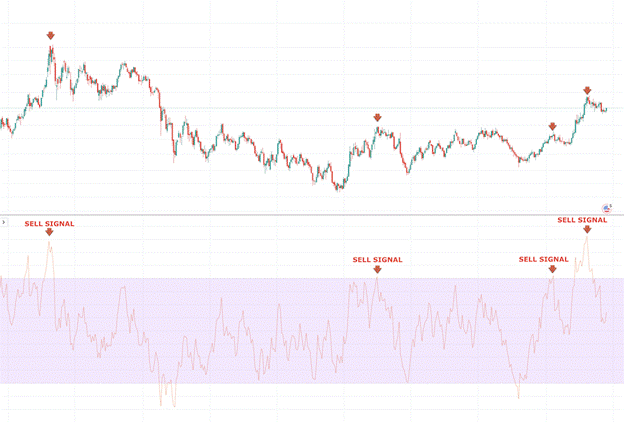
Spotting Trend Reversals With RSI Divergences
Traders can also watch for a large divergence between price action and the Relative Strength Index reading. First, the asset must reach oversold or overbought conditions following a large move. Then the price makes a second peak or trough, while the RSI moves in the opposite direction of the price movement. This often suggests that a trend reversal may be coming. In the below example, a powerful move follows an RSI divergence.
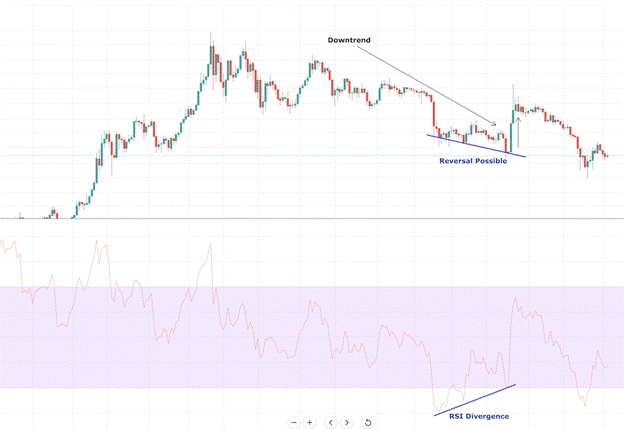
Midline Trading Using Relative Strength Index
Readings below 30 and 70 indicate oversold or overbought conditions, and present traders with a buy or sell signal they can take action based on. However, some traders prefer to miss out on trying to catch tops or bottoms using the vanilla RSI strategy and often opt to take a position based on a cross of the midline on the RSI. In the following sample, the RSI midline reading of 50 can be seen acting as a buy or sell signal depending on which direction the price passes through the midline from. The example also depicts the midline reading acting as resistance and support at times.
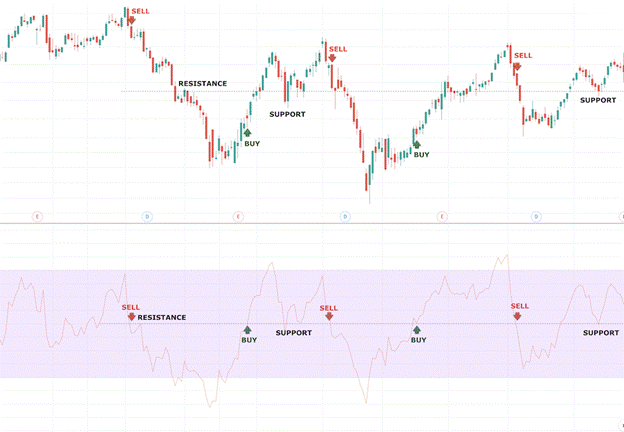
RSI Trendlines Act As Support or Resistance
Drawing trendlines on charts isn’t just for candlesticks. These lines can be drawn on RSI readings, potentially providing traders with clues on where support or resistance may lie. In the following sample, the RSI was supported by a trendline for weeks, until the signal broke below the trendline. When it rose once again, the broken trendline is now acting as powerful resistance.
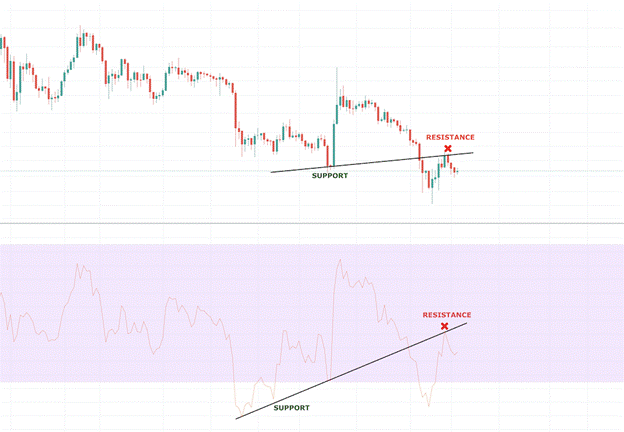
Support and Resistance Flip Signals Using RSI
The Relative Strength Index can also be used as a buy or sell signal when the indicator returns to a previous level of support and resistance to confirm an S/R flip. If the price and RSI bounce at a previous S/R flip level, a trader can take a position. In the following example, after Ripple broke through resistance in both price and RSI, both eventually came back down to confirm the previous resistance as support, before the asset’s price rose once again.
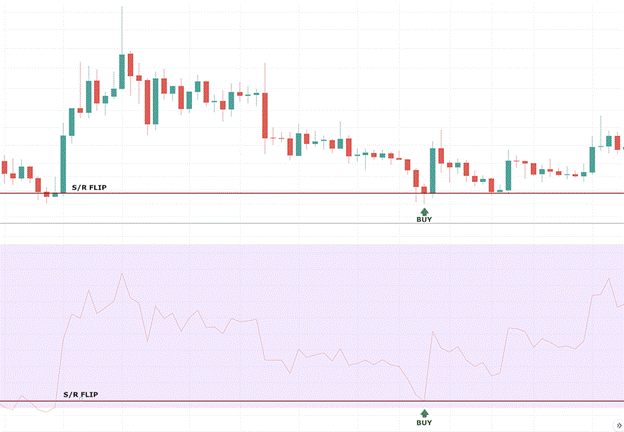
Tips for Traders And Common Mistakes
Traders can watch for divergences in price and RSI to discover price action that doesn’t match momentum, which typically suggests that a trend is about to fail and reverse.
Traders may opt to adjust the signal to filter out noise by only taking buy or sell trades when the indicator reaches below or above 80/20, or even 90/10, rather than the normal 70/30. This limits the amount of trades taken using this strategy, but any positions taken from such extreme oversold or overbought conditions typically result in a safe, effective, and profitable trade.
Traders should watch for backtests of certain RSI levels to confirm as support or resistance.
Combining the RSI with other indicators can be a one-two-punch strategy, where traders can use one indicator to double-confirm the other. When further combined with price patterns or candlestick patterns, the results can be significant.
Trader Larry Connors has created an RSI 2 strategy, by adjusting the settings of the indicator to 2-periods, and moving the signal levels to 95 and 5. Then, the 200EMA is used to determine if a long or short position should be taken. It’s an advanced strategy that can yield exceptional results.
Conclusion
With the Relative Strength Index fully explained, you are already well on your way to becoming a day trader. On PrimeXBT, learning to day trade assets like crypto, forex, commodities, and more can be simple, safe, and effective.
PrimeXBT offers up to 1000x leverage across a variety of financial markets, from traditional assets like gold, stock indices, and forex currencies, to digital assets like Bitcoin and other cryptocurrencies.
The advanced trading platform offers professional trading tools that are easy to understand, along with extensive training materials and a helpful support staff eager to assist you with getting started. Sign-up takes less than 60 seconds, register today!
The content provided here is for informational purposes only. It is not intended as personal investment advice and does not constitute a solicitation or invitation to engage in any financial transactions, investments, or related activities. Past performance is not a reliable indicator of future results.
The financial products offered by the Company are complex and come with a high risk of losing money rapidly due to leverage. These products may not be suitable for all investors. Before engaging, you should consider whether you understand how these leveraged products work and whether you can afford the high risk of losing your money.
The Company does not accept clients from the Restricted Jurisdictions as indicated in our website/ T&C. Some services or products may not be available in your jurisdiction.
The applicable legal entity and its respective products and services depend on the client’s country of residence and the entity with which the client has established a contractual relationship during registration.




